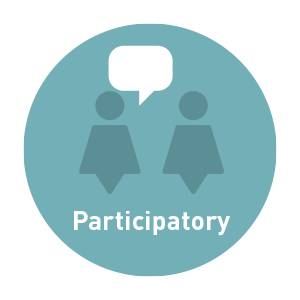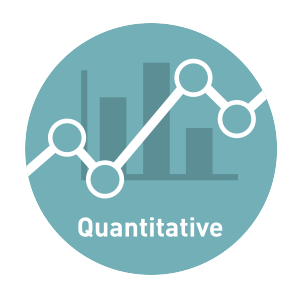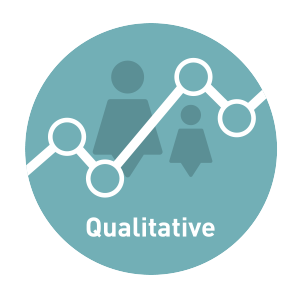
PARTICIPATORY EVALUATION METHODS
Participatory evaluation is an approach that involves the stakeholders of a program in the evaluation process. This can occur at any stage of the evaluation process: design, data collection and analysis, and reporting. A participatory approach can be taken with any impact evaluation design and with quantitative and qualitative data. The purpose of the evaluation will dictate the type and level of stakeholder involvement, and this will maximize the effectiveness of the approach. When done well, this approach can empower participants and aligns with the key principles for measuring empowerment. Participatory evaluation approaches are practiced in a variety of ways: self-assessment, stakeholder evaluation, internal evaluation and joint evaluation. It can also include storytelling, participatory social mapping, outcome mapping, causal linkage and trend and change diagramming, scoring, and brainstorming on program strengths and weaknesses.
PARTICIPATORY EVALUATION APPROACHES
-
Collecting stories and narratives – provides an insight into how people experience their lives. The process of collecting stories usually begins with an interview, whether in groups or in individual interviews. Story-telling is useful for evaluation, and can be used to focus on a particular intervention while also reflecting on the different contextual factors that influence outcomes.
-
Participatory visual storytelling – this an umbrella term for a variety of methodologies embedded in action research used to empower project participants in telling their life story through digital media such as photography or video.
-
Life histories – these can be collected through semi or unstructured interviews to develop highly nuanced narratives of individual’s experiences relating to social norms and attitudes, and to track changes in individual awareness or beliefs about gender roles.
-
Sensemaker – a narrative-based research methodology to collect and analyze large numbers of stories for understanding complex change, with active participation of project participants. It involves a dedicated software package for collection and analysis.
-
Case studies – a useful tool that captures a clear story or example of the processes or experiences of a program, in relation to specific domains of change. A number of different data collection methods can be used to build a case study and to triangulate the information retrieved.
-
Most Significant Change approach – a participatory method that looks for stakeholders’ perspectives on the impact of a program. Putting this method into action can involve both semi-structured interviews to gather participants stories about change, and focus group discussions to determine whether stories most accurately describe the changes occurring.
-
Voice, Action Comportment and Opportunity (VACO) checklist – this checklist is an evaluation tool used to measure girls’ empowerment and leadership. It links program staff’s observations and participant’s self-reports of skill building. (See Appendix 2).
-
Journals or log keeping – a useful method for tracking lessons learned and challenges as they are experienced during the implementation and/ or evaluation of a program, from the perspective of those involved.

